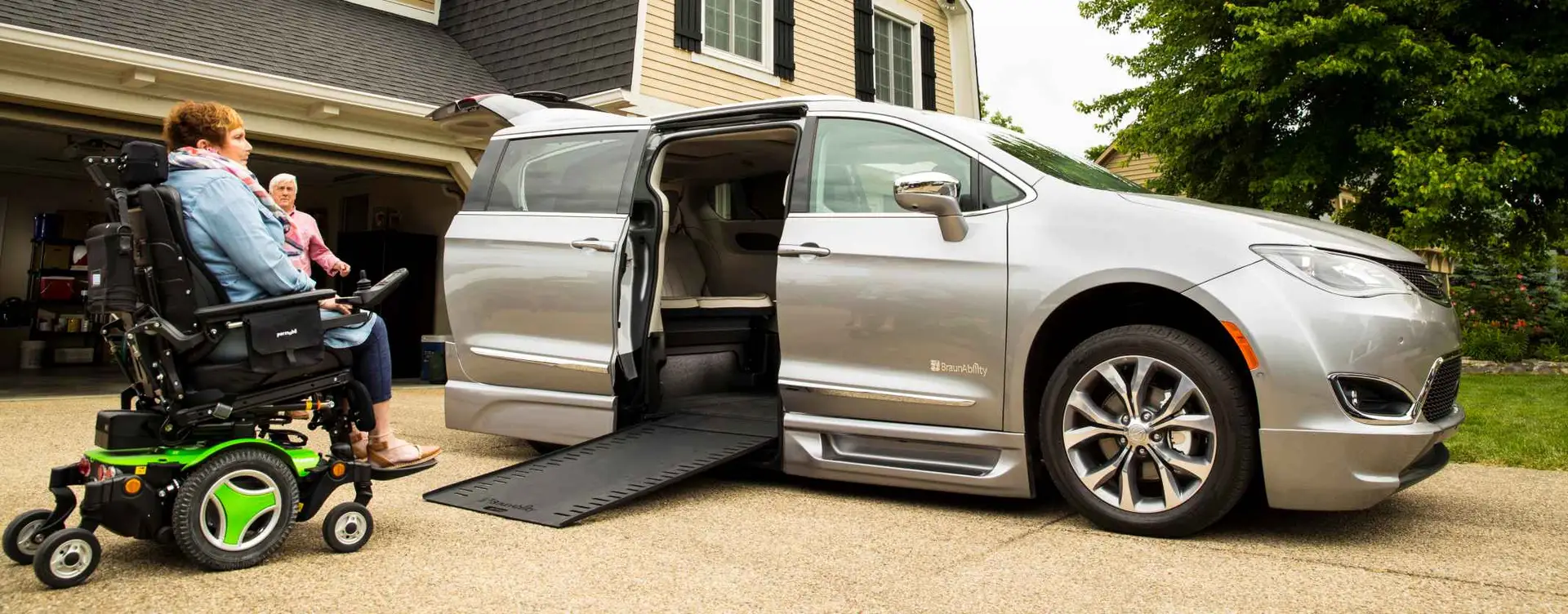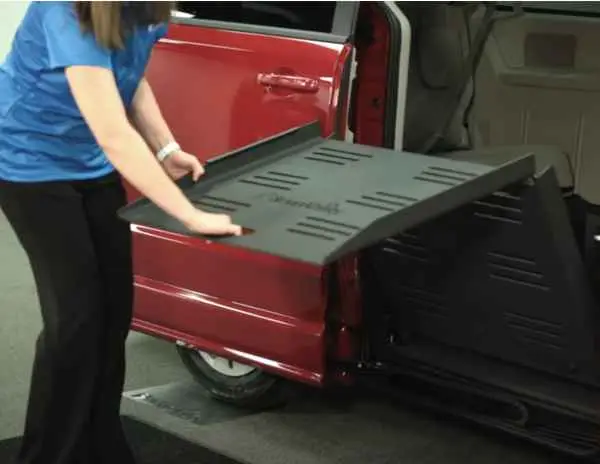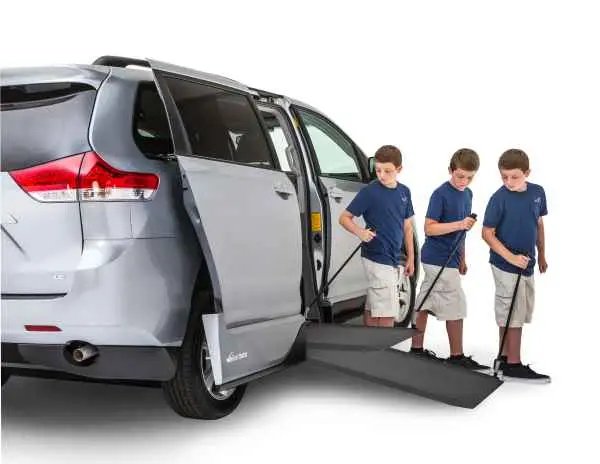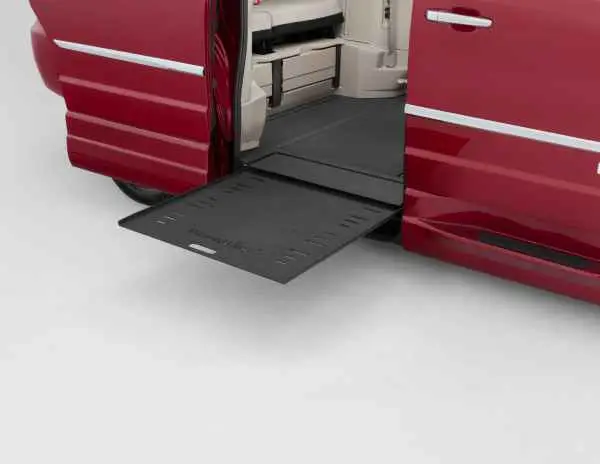
Side-entry wheelchair-accessible vans are the most popular conversion type available today, offering unmatched flexibility, freedom, and interior space. This layout allows wheelchair users to drive from their chair, ride as a front-seat passenger, or transfer to factory seating with ease. It also provides more interior maneuverability compared to rear-entry designs.
Side-entry conversions come in a wide range of options, including manual or power-operated fold-out ramps and manual or power in-floor ramps, allowing users to choose the configuration that best suits their lifestyle and mobility needs.
The fold-out wheelchair ramp conversion is the most widely used and trusted ramp style in side-entry accessible vans. Built from high-strength aluminum, these ramps support up to 1,000 lbs. and can be either manual or power-operated, depending on the selected conversion.
In side-entry applications, the ramp is installed inside the passenger-side doorway and folds outward for deployment. Its straightforward design makes it ideal for use on uneven surfaces and easier to operate during power failures, offering dependable access in various situations.
The in-floor wheelchair ramp is the second primary ramp option for side-entry accessible vans. Unlike fold-out ramps that stow inside the doorway, in-floor ramps slide out from beneath the vehicle’s floor, creating a clean, obstacle-free entryway for ambulatory passengers and providing more open space inside the cabin.
Despite the difference in how it deploys, an in-floor ramp can be configured for manual or power operation, depending on the specific conversion. This ramp type offers a sleek, concealed design without compromising functionality or accessibility.
Every side-entry wheelchair-accessible van available today features one of four main ramp system configurations. Each ramp type is designed to meet specific mobility needs, vehicle preferences, and user lifestyles. Choosing the right ramp system—manual or power, fold-out or in-floor—is one of the most important decisions when selecting the ideal accessible van conversion for yourself or your family.

The manual fold-out ramp is commonly used in side-entry wheelchair van conversions designed for individuals who always travel with a caregiver or companion. This ramp is mounted inside the passenger-side doorway and blocks entry when stowed, requiring deployment for access. To use, the caregiver must manually pull the ramp out from the vehicle.
Fewer moving parts; no electronics
Lower maintenance
Lower overall conversion cost
Requires light lifting and bending
Exposure to weather during ramp deployment
Entry blocked unless the ramp is deployed

The manual in-floor ramp is a popular side-entry option for wheelchair users who travel with a caregiver or companion. Unlike fold-out ramps, this system is stored beneath the vehicle’s floor on the passenger side, leaving the doorway completely unobstructed for ambulatory passengers. The ramp must be manually pulled out using a handle, offering a clean and functional design without reliance on electronics.
Fewer moving parts; no electronics
Low maintenance
Lower overall conversion cost
No ramp blocks the doorway when stowed
The user is exposed to outdoor elements during ramp deployment

The power fold-out ramp is the most widely used side-entry ramp system for wheelchair-accessible vans. With the push of a button, the ramp automatically deploys and stows, making it ideal for individuals who travel independently or with a caregiver. This ramp is mounted inside the passenger-side doorway and can be operated using interior controls or the factory key fob, offering convenience and ease of access in most environments.
Easy, push-button operation
No lifting or bending required
Includes a power backup system
More moving parts and electronics
Higher potential repair and maintenance costs

The power in-floor ramp is a popular choice for side-entry wheelchair vans, especially for those who frequently travel with ambulatory passengers. Because the ramp is stored beneath the floor, it leaves the passenger-side doorway clear, allowing easier entry and exit for others. With push-button operation—from inside the cabin or via the factory key fob—this system offers both convenience and a clean interior layout.
Ramp remains out of sight—no obstruction at the doorway
Simple, push-button operation
Includes a power backup system
A more complex system with additional moving parts
Shorter side-edge ramp barriers
Higher overall conversion cost
No matter which ramp type you choose, the vehicle chassis and interior specifications are just as critical when shopping for a new or used wheelchair-accessible van. Since every person has unique mobility needs—such as seated height, wheelchair size, or transfer ability—there’s no one-size-fits-all solution. Additionally, every chassis manufacturer (e.g., Chrysler, Honda, Toyota, Dodge) varies in interior dimensions, entry heights, and floor configurations, making each conversion distinct.
That’s why it’s essential to review carefully:
Door opening heights and widths
Ramp width and angle
Interior floor layout and lowered floor length
We strongly recommend working with a certified mobility consultant to avoid costly mistakes and ensure the vehicle meets your current and future needs. A consultant can help match you with the right vehicle and conversion style, and even provide an opportunity to test-fit different options.
For more information or to schedule a FREE consultation, follow the links below to connect with a trusted mobility expert.